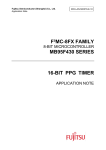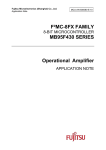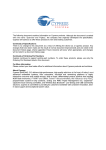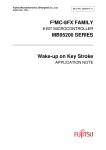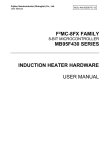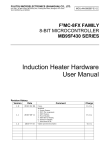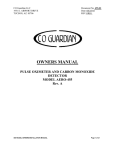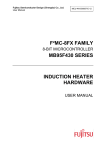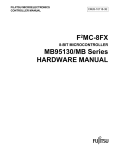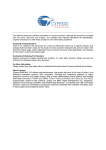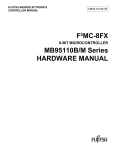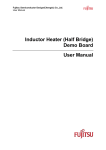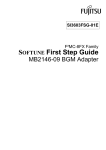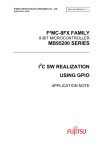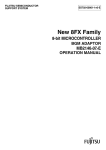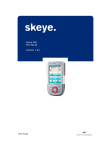Download User Manual, Guide Book, Application Notes and Some
Transcript
Fujitsu Microelectronics (Shanghai) Co., Ltd.
Application Note
MCU-AN-500078-E-10
F²MC-8FX FAMILY
8-BIT MICROCONTROLLER
MB95F430 SERIES
16-bit PPG Timer
APPLICATION NOTE
16bit PPG Timer Version 1.0
Revision History
Revision History
Date
2010-03-16
Author
Folix
Change of Records
V1.0, First draft
This manual contains 28 pages.
1.
The products described in this manual and the specifications thereof may be changed without prior notice.
To obtain up-to-date information and/or specifications, contact your Fujitsu sales representative or Fujitsu
authorized dealer.
2.
Fujitsu will not be liable for infringement of copyright, industrial property right, or other rights of a third party
caused by the use of information or drawings described in this manual.
3.
The contents of this manual may not be transferred or copied without the express permission of Fujitsu.
4.
The products contained in this manual are not intended for use with equipment which require extremely
high reliability such as aerospace equipments, undersea repeaters, nuclear control systems or medical
equipments for life support.
5.
Some of the products described in this manual may be strategic materials (or special technology) as
defined by the Foreign Exchange and Foreign Trade Control Law. In such cases, the products or portions
thereof must not be exported without permission as defined under the law.
© 2010 Fujitsu Microelectronics (Shanghai) Co., Ltd
MCU-AN-500078-E-10 - Page 2
16bit PPG Timer Version 1.0
Table of Contents
Table of Contents
Revision History .............................................................................................................2
Table of Contents ...........................................................................................................3
1 Introduction ..............................................................................................................4
2 PPG Overview .........................................................................................................5
2.1 Background ....................................................................................................5
2.2 PPG Formats..................................................................................................5
3 16bit PPG Timer Description ...................................................................................6
3.1 Block Diagram of 16bit PPG Timer .................................................................7
3.2 Pins of 16bit PPG Timer .................................................................................7
3.3 Registers List of 16bit PPG Timer ..................................................................7
3.4 16bit PPG Down Counter Registers ...............................................................8
3.5 16bit PPG Cycle Setting Buffer Registers ......................................................9
3.6 16bit PPG Duty Setting Buffer Registers ......................................................10
3.7 16bit PPG Status Control Registers .............................................................11
3.8 16bit PPG trigger source control Register ....................................................13
3.9 PPG Macro general setting procedure .........................................................14
4 Interrupts of 16bit PPG Timer ................................................................................15
4.1 Interrupt Control Bits and Interrupt Sources of 16-bit PPG Timer.................15
4.2 Register and Vector Table Addresses Related to Interrupts of 16bit PPG
Timer.....................................................................................................................15
5 PPG Trigger ...........................................................................................................16
6 PPG Driver.............................................................................................................19
6.1 Peripheral Usage ..........................................................................................19
6.2 Driver Code ..................................................................................................19
6.2.1 General Definition .................................................................................19
6.2.2 PPG Routine .........................................................................................20
7 Typical Application .................................................................................................21
7.1 HW Design ...................................................................................................21
7.2 Sample Code................................................................................................21
8 More Information....................................................................................................23
9 Appendix ................................................................................................................24
10
Sample Code ...................................................................................................25
MCU-AN-500078-E-10- Page 3
16bit PPG Timer Version 1.0
Chapter 1 Introduction
1 Introduction
This application note introduces how to use the PPG function on MB95F430 series.
Chapter 2 introduces the background and PPG formats.
Chapter 3 introduces PPG block, PPG registers, and the setting procedure.
Chapter 4 introduces PPG interrupt.
Chapter 5 introduces PPG drivers.
Chapter 6 introduces PPG application demo.
MCU-AN-500078-E-10 - Page 4
16bit PPG Timer Version 1.0
Chapter 2 PPG Overview
2 PPG Overview
Chapter 2 is an overview of PPG.
2.1 Background
It is generally used in communication, electronics, automation and so on. In
communication, the duty or frequency can be used to identify the protocol. In
electronics, it can be used to design switching power supply. In automation, it can be
used to control motors.
2.2 PPG Formats
PPG format consists of frequency and duty. PPG’s waveform is shown as below.
Figure 1. PPG Formats
MCU-AN-500078-E-10- Page 5
16bit PPG Timer Version 1.0
Chapter 3 16bit PPG Timer Description
3 16bit PPG Timer Description
16-bit PPG timer can output the waveform of PWM and one shot. The output waveform
can be reversed by setting the register (Normal polarity ↔ Inverted polarity).
Figure 2. 16bit PPG Timer
MCU-AN-500078-E-10 - Page 6
16bit PPG Timer Version 1.0
Chapter 3 16bit PPG Timer Description
3.1 Block Diagram of 16bit PPG Timer
Figure 3. Block Diagram of 16-bit PPG Timer
3.2 Pins of 16bit PPG Timer
The pins related to the 16-bit PPG timer namely are: PPG0 pin, TRG0 pin.
PPG0 is output pin. The PPG waveform can be outputted by using the 16-bit PPG
status control register to enable output (PCNTL0: POEN=1). TRG0 is used to start
16-bit PPG timer by hardware trigger.
3.3 Registers List of 16bit PPG Timer
Register
Description
PDCRH0
PDCRL0
PCSRH0
PCSRL0
PDUTH0
PDUTL0
PCNTH0
PCNTL0
PTGS0
16-bit PPG down counter register (upper)
16-bit PPG down counter register (lower)
16-bit PPG cycle setting buffer register (upper)
16-bit PPG cycle setting buffer register (lower)
16-bit PPG duty setting buffer register (upper)
16-bit PPG duty setting buffer register (lower)
16-bit PPG status control register (upper)
16-bit PPG status control register (lower)
16-bit PPG trigger source control register
MCU-AN-500078-E-10- Page 7
16bit PPG Timer Version 1.0
Chapter 3 16bit PPG Timer Description
3.4 16bit PPG Down Counter Registers
The 16-bit PPG down counter registers (upper, lower) (PDCRH0, PDCRL0) form a
16-bit register which is used to read the count value from the 16-bit PPG down-counter.
These registers form a 16-bit register which is used to read the count value from the
16-bit down-counter.
The initial values of the register are all "0".
Always use one of the following procedures to read from this register.
•Use "MOVW" instruction (use a 16-bit access instruction to read the PDCRH0 register
address)
•Use "MOV" instruction, and read PDCRH0 first and then PDCRL0 (reading PDCRH0
automatically copies the lower 8 bits of the down-counter to PDCRL0).
These registers are read-only and writing has no effect on the operation.
Figure 4. 16bit PPG Down Counter Register
MCU-AN-500078-E-10 - Page 8
16bit PPG Timer Version 1.0
Chapter 3 16bit PPG Timer Description
3.5 16bit PPG Cycle Setting Buffer Registers
The 16-bit PPG cycle setting buffer registers are used to set the cycle for the output
pulses generated by the PPG.
These registers form a 16-bit register which sets the period for the output pulses
generated by the PPG. The values set in these registers are loaded to the
down-counter.
When writing to these registers, always use one of the following procedures.
•Use "MOVW" instruction (use a 16-bit access instruction to write to the PCSRH0
register address)
•Use "MOV" instruction, and write to PCSRH0 first and then PCSRL0.
If a down-counter load occurs after writing data to PCSRH0 (but before writing data to
PCSRL0), the previous valid PCSRH0/PCSRL0 value will be loaded to the
down-counter. If the PCSRH0/PCSRL0 value is modified during counting, the modified
value will become effective from the next load of the down-counter.
•Do not set PCSRH0 and PCSRL0 to "00H", or PCSRH0 to "01H" and PCSRL0 to
"01H".
Figure 5. 16bit PPG Cycle Register
MCU-AN-500078-E-10- Page 9
16bit PPG Timer Version 1.0
Chapter 3 16bit PPG Timer Description
3.6 16bit PPG Duty Setting Buffer Registers
The 16-bit PPG duty setting buffer registers control the duty ratio for the output pulses
generated by the PPG.
These registers form a 16-bit register which controls the duty ratio for the output pulses
generated by the PPG. Transfer of the data from the 16-bit PPG duty setting buffer
registers to the duty setting registers is performed at the same timing as the
down-counter read.
When writing to these registers, always use one of the following procedures.
•Use "MOVW" instruction (use a 16-bit access instruction to write to the PDUTH0
register address).
•Use "MOV" instruction, and write to PDUTH0 first and then PDUTL0.
If a down-counter load occurs after writing data to PDUTH0 (but before writing data to
PDUTL0), the value of the 16-bit PPG duty setting buffer registers is not transferred to
the duty setting registers.
The relation between the value of the 16-bit PPG duty setting registers and output pulse
is as follows:
•When the same value is set in both the 16-bit PPG cycle setting buffer registers and
duty setting registers, the "H" level will always be outputted if normal polarity is set, or
the "L" level will always be outputted if inverted polarity is set.
•When the duty setting registers are set to "00B", the "L" level will always be outputted if
normal polarity is set, or the "H" level will always be outputted if inverted polarity is set.
•When the value set in the duty setting registers is greater than the value in the 16-bit
PPG cycle setting buffer registers, the "L" level will always be outputted if normal
polarity is set, and the "H" level will always be outputted if inverted polarity is set.
Figure 6. 16bit PPG Duty Register
MCU-AN-500078-E-10 - Page 10
16bit PPG Timer Version 1.0
Chapter 3 16bit PPG Timer Description
3.7 16-bit PPG Status Control Registers
The 16-bit PPG status control register is used to enable and disable the 16-bit PPG
timer and also to set the operating status for the software trigger, retrigger control
interrupt, and output polarity. This register can also check the operation status.
Figure 7. 16bit PPG Status Control Register, Upper Byte (PCNTH0)
MCU-AN-500078-E-10- Page 11
16bit PPG Timer Version 1.0
Chapter 3 16bit PPG Timer Description
Figure 8. 16bit PPG Status Control Register, Lower Byte (PCNTL0)
MCU-AN-500078-E-10 - Page 12
16bit PPG Timer Version 1.0
Chapter 3 16bit PPG Timer Description
3.8 16-bit PPG Trigger Source Control Register
The 16-bit PPG trigger source control register controls the trigger source of the 16-bit
PPG timer.
Figure 9. 16bit PPG Trigger Source Control Register (PTGS0)
MCU-AN-500078-E-10- Page 13
16bit PPG Timer Version 1.0
Chapter 3 16bit PPG Timer Description
3.9 PPG Macro General Setting Procedure
● Initial setup
1) Set the interrupt level. (ILR3, ILR4)
2) Enable the hardware trigger and interrupts, select the interrupt type, and enable
output. (PCNTL0)
3) Select the count clock and the mode, and enable timer operation. (PCNTH0)
4) Set the cycle. (PCSRH0, PCSRL0)
5) Set the duty. (PDUTH0, PDUTL0)
6) Start the PPG by the software trigger. (PCNTH0: STRG = 1)
● Interrupt processing
1) Process any interrupt.
2) Clear the interrupt request flag. (PCNTL0: IRQF)
MCU-AN-500078-E-10 - Page 14
16bit PPG Timer Version 1.0
Chapter 4 Interrupts of 16bit PPG Timer
4 Interrupts of 16bit PPG Timer
This chapter introduces PPG interrupt
The 16-bit PPG timer can generate interrupt requests in the following cases:
•When a trigger or counter borrow occurs
•When a rising edge of PPG is generated in normal polarity
•When a falling edge of PPG is generated in inverted polarity
The interrupt operation is controlled by IRS1 (bit3) and IRS0 (bit2) in the PCNTL
register.
4.1 Interrupt Control Bits and Interrupt Sources of 16-bit PPG Timer
4.2 Register and Vector Table Addresses Related to Interrupts of
16bit PPG Timer
MCU-AN-500078-E-10- Page 15
16bit PPG Timer Version 1.0
Chapter 5 PPG Trigger
5 PPG Trigger
This chapter introduces PPG trigger.
PPG is activated by TRG input or internal voltage comparator (VC) input.
Condition 1: PPG start triggering and stop triggering do not occur simultaneously.
(1) TRG
When STS1 and STS0 are set to "00B", SPS2, SPS1 and SPS0 are set to "000B",
EGS1 and EGS0 are set to "11B", and the hardware trigger input from TRG is used, the
16-bit PPG timer starts operating at a rising edge and stops upon the detection of a
falling edge. Moreover, the 16-bit PPG timer also starts operating at the following rising
edge from the beginning.
The operation can be re-triggered by a valid TRG input hardware trigger regardless of
the retrigger setting of the RTRG bit when the TRG input hardware trigger has been
selected.
Figure 10. Trigger from TRG in PWM Mode
(2) Voltage comparator (VC)
When STS1 and STS0 are set to "01B", SPS2, SPS1 and SPS0 are set to "101B", and
the hardware trigger input from the VC ch. 0 is used, the 16-bit PPG timer starts
operating at a rising edge of VC ch. 0 and stops upon the detection of a falling edge of
VC ch.1/2/3.
Moreover, the 16-bit PPG timer also starts operating at the following rising edge of VC
ch. 0 from the beginning.
The operation can be re-triggered by a valid rising edge of VC ch. 0 input hardware
trigger regardless of the retrigger setting of the RTRG bit when the VC ch. 0 input
hardware trigger has been selected.
MCU-AN-500078-E-10 - Page 16
16bit PPG Timer Version 1.0
Chapter 5 PPG Trigger
Figure 11. Trigger from VC in PWM Mode
Condition 2: PPG start triggering and stop triggering occur simultaneously.
When STS1 and STS0 are set to "01B", SPS2, SPS1 and SPS0 are set to "001B", and
if the hardware triggers from a rising edge of VC ch. 0 and another rising edge of VC ch.
1 occur simultaneously, the PPG will halt (the stop trigger has higher priority than the
start trigger.).
MCU-AN-500078-E-10- Page 17
16bit PPG Timer Version 1.0
Chapter 5 PPG Trigger
Figure 12. Trigger Start and Stop Occur Simultaneously in PWM Mode
MCU-AN-500078-E-10 - Page 18
16bit PPG Timer Version 1.0
Chapter 6 PPG Driver
6 PPG Driver
The chapter introduces PPG driver.
6.1 Peripheral Usage
The MCU pins are used as below:
PPG0 is used as PPG wave output;
TRG0 is used as PPG trigger.
6.2 Driver Code
6.2.1 General Definition
typedef unsigned char
typedef unsigned char
typedef signed
char
typedef unsigned int
typedef signed
int
typedef unsigned long
typedef signed
long
#define BOOL
#define BYTE
#define UBYTE
#define WORD
#define UWORD
#define LONG
#define ULONG
#define UCHAR
#define UINT
#define DWORD
BOOLEAN;
INT8U;
INT8S;
INT16U;
INT16S;
INT32U;
INT32S;
/* Unsigned 8 bit quantity */
/* Signed
8 bit quantity */
/* Unsigned 16 bit quantity */
/* Signed
16 bit quantity */
/* Unsigned 32 bit quantity */
/* Signed
32 bit quantity */
BOOLEAN
INT8U
INT8U
INT16U
INT16U
INT32S
INT32U
INT8U
INT16U
INT32U
#define TRUE
#define FALSE
1
0
#define BYTE_LO(w)
#define BYTE_HI(w)
((UBYTE)(w))
((UBYTE)(((UWORD)(w)>>8)&0xFF))
MCU-AN-500078-E-10- Page 19
16bit PPG Timer Version 1.0
Chapter 6 PPG Driver
6.2.2 PPG Routine
void PPGOpen()
Return
Parameters
Description
Example
: none.
: none.
: open the PPG function.
: PPGOpen();
void PPGOpen()
{
DDR7_P73=1;
PCNTH0_PGMS=0;//Open PPG
}
void PPGClose ()
Return
: none.
Parameters
: none.
Description
: close the PPG function.
Example
: PPGClose();
void PPGClose()
{
DDR7_P73=1;
PCNTH0_PGMS=1;//Close PPG
}
void PPGSet(WORD usCycle,WORD usDuty)
Return
: none.
Parameters
: usCycle, is PPG cycle(us)
usDuty, is PPG duty(us)
Description
: set the PPG function.
Example
: PPGSet(40,10);
void PPGSet(WORD usCycle,WORD usDuty)
{
DDR7_P73=1;
//PPG0
PCSRH0=BYTE_HI(usCycle);//Upper Byte
PCSRL0=BYTE_LO(usCycle);//Lower Byte
PDUTH0=BYTE_HI(usDuty);//Upper Byte
PDUTL0=BYTE_LO(usDuty);//Lower Byte
PCNTH0=0xF7;//Mask=1,1.000us(MCLK/8),OneShot,Soft Trigger
PCNTL0=0x0E;//OSEL=L,IREN=0
}
MCU-AN-500078-E-10 - Page 20
16bit PPG Timer Version 1.0
Chapter 7 Typical Application
7 Typical Application
The chapter introduces the typical application of PPG.
7.1 HW Design
In this application, we will use the PPG to drive a buzzer. VC0 rising edge starts PPG,
and VC1 rising edge stops PPG (PTGS0=0x05). The MCU is MB95F430K. The HW is
designed as below.
Figure 13. Hardware Design
7.2 Sample Code
void main(void)
Return
: none.
Parameters : none;
Description : system main program.
Example
: main();
MCU-AN-500078-E-10- Page 21
16bit PPG Timer Version 1.0
Chapter 7 Typical Application
void main(void)
{
__DI();
__set_il(3);
InitIrqLevels();
WDTH =0xA5;//Disable WTG
WDTL =0x96;
WATR =0xEE;
SYCC =0xF0;//Main Clock
SYCC2=0xF4;//Main Clock
SYSC =0xBC;//BUZZ(P01)
SYSC2 =0x02;//PPG(P73),Disable I2C
while(!STBC_MRDY);
__EI();
PTGS0=0x05;//VC0 rising edge start PPG,VC1 rising edge stop PPG
PPGSet(200,10);
PPGOpen();
PPGClose();
}
MCU-AN-500078-E-10 - Page 22
16bit PPG Timer Version 1.0
Chapter 8 More Information
8 More Information
For more information on FUJITSU MB95200 products, please visit following website:
English Version http://www.fujitsu.com/cn/fmc/en/services/mcu/mb95430/
Simplified Chinese Version http://www.fujitsu.com/cn/fmc/services/mcu/mb95430/
MCU-AN-500078-E-10- Page 23
16bit PPG Timer Version 1.0
Chapter 9 Appendix
9 Appendix
Figure 1. PPG Formats ..................................................................................................... 5
Figure 2. 16bit PPG Timer ................................................................................................ 6
Figure 3. Block Diagram of 16-bit PPG Timer ............................................................... 7
Figure 4. 16bit PPG down counter registor .................................................................... 8
Figure 5. 16bit PPG cycle registor ................................................................................... 9
Figure 6. 16bit PPG duty registor .................................................................................. 10
Figure 7. 16bit PPG Status Control Register, Upper Byte (PCNTH0) ..................... 11
Figure 8. 16bit PPG Status Control Register, Lower Byte (PCNTL0)...................... 12
Figure 9. 16bit PPG trigger source control Register (PTGS0) .................................. 13
Figure 10. Trigger from TRG in PWM Mode ................................................................ 16
Figure 11. Trigger from VC in PWM Mode ................................................................... 17
Figure 12. Triggers Start and Stop Occur Simultaneously in PWM Mode .............. 18
Figure 13. Hardware design ........................................................................................... 21
MCU-AN-500078-E-10 - Page 24
16bit PPG Timer Version 1.0
Chapter 10 Sample Code
10 Sample Code
main.c
/*---------------------------------------------------------------------------*/
/* Title : Sample main program for sensorless DC inverter control
/* Aurthor : Folix Li
*/
/* Date : 26th Nov 2999
*/
/*---------------------------------------------------------------------------*/
#include "mb95430.h"
#include "TypeDef.h"
/*---------------------------------------------------------------------------*/
/* PWM Control
/*---------------------------------------------------------------------------*/
void PPGOpen()
{
DDR7_P73=1;
PCNTH0_PGMS=0;
}
void PPGClose()
{
DDR7_P73=1;
PCNTH0_PGMS=1;
}
void PPGSet(WORD usCycle,WORD usDuty)
{
DDR7_P73=1;
//PPG0
PCSRH0=BYTE_HI(usCycle);//Upper Byte
PCSRL0=BYTE_LO(usCycle);//Lower Byte
PDUTH0=BYTE_HI(usDuty);//Upper Byte
PDUTL0=BYTE_LO(usDuty);//Lower Byte
PCNTH0=0xF7;//Mask=1,1.000us(MCLK/8),OneShot,Soft Trigger
PCNTL0=0x0E;//OSEL=L,IREN=0
}
void main(void)
{
__DI();
__set_il(3);
InitIrqLevels();
WDTH =0xA5;
WDTL =0x96;
MCU-AN-500078-E-10- Page 25
*/
16bit PPG Timer Version 1.0
Chapter 10 Sample Code
WATR =0xEE;
SYCC =0xF0;//Main Clock
SYCC2=0xF4;//Main Clock
SYSC =0xBC;//BUZZ(P01)
SYSC2 =0x02;//PPG(P73),Disable I2C
while(!STBC_MRDY);
__EI();
PTGS0=0x05;//VC0 rising edge start PPG,VC1 rising edge stop PPG
PPGSet(200,10);
PPGOpen();
PPGClose();
}
VECTORS.C
/* THIS SAMPLE CODE IS PROVIDED AS IS AND IS SUBJECT TO ALTERATIONS.
FUJITSU */
/* MICROELECTRONICS ACCEPTS NO RESPONSIBILITY OR LIABILITY FOR ANY
ERRORS OR */
/*
ELIGIBILITY
FOR
ANY
PURPOSES.
*/
/*
(C) Fujitsu Microelectronics Europe GmbH
*/
/*--------------------------------------------------------------------------VECTORS.C
- Interrupt level (priority) setting
- Interrupt vector definition
29.09.04 1.00
HWe
V30L29
-----------------------------------------------------------------------------*/
#include "mb95430.h"
/*--------------------------------------------------------------------------InitIrqLevels()
This function pre-sets all interrupt control registers. It can be used
to set all interrupt priorities in static applications. If this file
contains assignments to dedicated resources, verify that the
appropriate controller is used.
NOTE: value 0xFF disables the interrupt and value 0 sets highest priority.
NOTE: For all resource interrupts exists 3 Interrupt level registers (ILRx).
Each register sets the level for 4 different resources (IRQx).
NOTE: This list is prepared for the 8FX-emulation chip MB95FV100 'Horn'.
Not all resources will be supported by all 8FX-devices
-----------------------------------------------------------------------------*/
void InitIrqLevels(void)
{
MCU-AN-500078-E-10 - Page 26
16bit PPG Timer Version 1.0
Chapter 10 Sample Code
/*
ILRx
IRQs defined by ILRx */
ILR0 = 0xFF;
// IRQ0:
// IRQ1:
// IRQ2:
// IRQ3:
external interrupt ch0 | ch4
external interrupt ch1 | ch5
external interrupt ch2 | ch6
external interrupt ch3 | ch7
ILR1 = 0xFF;
// IRQ4: UART/SIO ch0
// IRQ5: 8/16-bit timer ch0 (lower)
// IRQ6: 8/16-bit timer ch0 (upper)
// IRQ7: Output Compare ch0
ILR2 = 0xFF;
// IRQ8: Output Compare ch1
// IRQ9: none
// IRQ10: Voltage Compare ch0
// IRQ11: Voltage Compare ch1
ILR3 = 0xFF;
// IRQ12: Voltage Compare ch2
// IRQ13: Voltage Compare ch3
// IRQ14: 16-bit free run timer
// IRQ15: 16-bit PPG0
ILR4 = 0xFF;
// IRQ16: I2C ch0
// IRQ17: none
// IRQ18: 10-bit A/D-converter
// IRQ19: Timebase timer
ILR5 = 0xFF;
// IRQ20: Watch timer
// IRQ21: none
// IRQ22: none
// IRQ23: Flash Memory
}
/*--------------------------------------------------------------------------Prototypes
Add your own prototypes here. Each vector definition needs is prototype. Either do it here or include a header file containing them.
-----------------------------------------------------------------------------*/
__interrupt void DefaultIRQHandler(void);
/*--------------------------------------------------------------------------Vector definiton
Use following statements to define vectors.
All resource related vectors are predefined.
Remaining software interrupts can be added hereas well.
-----------------------------------------------------------------------------*/
#pragma intvect DefaultIRQHandler 0
// IRQ0: external interrupt ch0 | ch4
#pragma intvect DefaultIRQHandler 1
// IRQ1: external interrupt ch1 | ch5
MCU-AN-500078-E-10- Page 27
16bit PPG Timer Version 1.0
Chapter 10 Sample Code
#pragma intvect DefaultIRQHandler 2
#pragma intvect DefaultIRQHandler 3
//
//
IRQ2: external interrupt ch2 | ch6
IRQ3: external interrupt ch3 | ch7
#pragma intvect DefaultIRQHandler 4
#pragma intvect DefaultIRQHandler 5
#pragma intvect DefaultIRQHandler 6
#pragma intvect DefaultIRQHandler 7
// IRQ4: UART/SIO ch0
// IRQ5: 8/16-bit timer ch0 (lower)
// IRQ6: 8/16-bit timer ch0 (upper)
// IRQ7: Output Compare ch0
#pragma intvect DefaultIRQHandler 8
//
#pragma intvect DefaultIRQHandler 9
//
#pragma intvect DefaultIRQHandler 10 //
#pragma intvect DefaultIRQHandler 11 //
IRQ8: Output Compare ch1
IRQ9: none
IRQ10: Voltage Compare ch0
IRQ11: Voltage Compare ch1
#pragma intvect DefaultIRQHandler 12
#pragma intvect DefaultIRQHandler 13
#pragma intvect DefaultIRQHandler 14
#pragma intvect DefaultIRQHandler 15
//
//
//
//
IRQ12: Voltage Compare ch2
IRQ13: Voltage Compare ch3
IRQ14: 16-bit free run timer
IRQ15: 16-bit PPG0
#pragma intvect DefaultIRQHandler 16
#pragma intvect DefaultIRQHandler 17
#pragma intvect DefaultIRQHandler 18
#pragma intvect DefaultIRQHandler 19
//
//
//
//
IRQ16: I2C ch0
IRQ17: none
IRQ18: 10-bit A/D-converter
IRQ19: Timebase timer
#pragma intvect DefaultIRQHandler 20 // IRQ20: Watch timer
#pragma intvect DefaultIRQHandler 21 // IRQ21: none
#pragma intvect DefaultIRQHandler 22 // IRQ22: none
#pragma intvect DefaultIRQHandler 23 // IRQ23: Flash Memory
/*--------------------------------------------------------------------------DefaultIRQHandler()
This function is a placeholder for all vector definitions.
Either use your own placeholder or add necessary code here
(the real used resource interrupt handlers should be defined in the main.c).
-----------------------------------------------------------------------------*/
__interrupt void DefaultIRQHandler(void)
{
__DI();
// disable interrupts
while(1)
__wait_nop();
// halt system
}
MCU-AN-500078-E-10 - Page 28




























